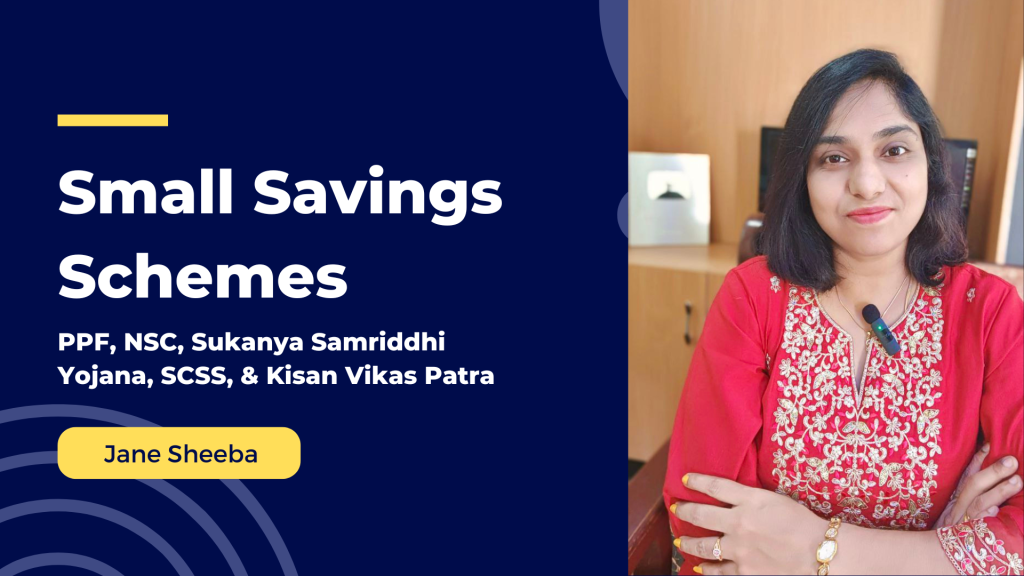
Small savings schemes are a cornerstone of financial planning for many Indian households, offering safe and stable investment options backed by the government. These schemes, available through post offices and select banks, are designed to cater to the needs of small and retail investors who seek assured returns without the volatility of market-linked investments.
The central government periodically revises the interest rates on these schemes to ensure they remain attractive to investors. In this blog, we’ll explore the features, benefits, and current interest rates of five popular small savings schemes: Public Provident Fund (PPF), National Savings Certificate (NSC), Sukanya Samriddhi Yojana (SSY), Senior Citizen Savings Scheme (SCSS), and Kisan Vikas Patra (KVP).
Public Provident Fund (PPF)
The Public Provident Fund (PPF) is a long-term savings vehicle that offers small investors a secure way to grow their money while enjoying tax benefits. As a government-backed scheme, PPF provides fixed returns, making it a reliable option for those looking to build a substantial corpus over time.
Key Features:
- Investment Tenure: PPF has a 15-year lock-in period, but investors have the option to extend the tenure in blocks of five years after maturity.
- Tax Benefits: PPF falls under the Exempt-Exempt-Exempt (EEE) category, meaning that the deposits, interest earned, and the maturity amount are all tax-exempt. Contributions of up to ₹1.5 lakh per year can be claimed as a deduction under Section 80C of the Income Tax Act.
- Interest Rate: The interest rate for PPF is currently set at 7.1% per annum, compounded annually. This rate is reviewed by the government every quarter.
Example: Suppose you invest ₹1.5 lakh annually in a PPF account. Over 15 years, with the power of compounding, your investment could grow significantly, offering you a substantial tax-free corpus at maturity.
Tip: To maximize your returns, try to make your PPF contributions at the beginning of the financial year, as the interest is calculated on the minimum balance between the 5th and last day of each month.
National Savings Certificate (NSC)
The National Savings Certificate (NSC) is a fixed-income investment that combines safety with decent returns. It is particularly popular among conservative investors who prefer a predictable and guaranteed return on their investment.
Key Features:
- Interest Rate: NSC offers a fixed interest rate of 7.7% per annum, compounded annually. This rate is locked in at the time of purchase, ensuring that investors are protected from future rate fluctuations.
- Tenure: The NSC matures in five years, making it suitable for medium-term financial goals.
- Minimum Investment: An NSC account can be opened with as little as ₹1,000, and there is no upper limit on the investment amount.
- Tax Benefits: Investments in NSC are eligible for a deduction under Section 80C of the Income Tax Act, up to ₹1.5 lakh per annum.
Example: If you invest ₹50,000 in an NSC today, at the end of five years, your investment will have grown to approximately ₹72,500, thanks to the compounded interest.
Tip: Since the interest earned on NSC is reinvested, it qualifies for a deduction under Section 80C in subsequent years, further reducing your tax liability.
Sukanya Samriddhi Yojana (SSY)
The Sukanya Samriddhi Yojana (SSY) is a government initiative aimed at securing the financial future of girl children. It offers an attractive interest rate and tax benefits, making it an ideal savings instrument for parents planning for their daughter’s education or marriage.
Key Features:
- Interest Rate: The SSY account currently offers an interest rate of 8.2% per annum, compounded annually.
- Eligibility: An SSY account can be opened by the parents or legal guardians of a girl child under the age of 10. A family can open a maximum of two accounts, one for each girl child.
- Investment Limits: The minimum deposit required to open an SSY account is ₹250, while the maximum deposit allowed in a financial year is ₹1.5 lakh.
- Tenure: The account matures 21 years from the date of opening, but contributions are required only for the first 15 years.
Example: By investing ₹1.5 lakh annually in an SSY account for your daughter, you can accumulate a substantial amount by the time she turns 21, ensuring that her education or marriage expenses are well-covered.
Tip: Start early to take full advantage of the power of compounding. The sooner you open the account, the more time your investment has to grow.
Senior Citizen Savings Scheme (SCSS)
The Senior Citizen Savings Scheme (SCSS) is designed to provide financial security and regular income to senior citizens in their retirement years. It is one of the safest investment options available, with the added benefit of tax savings.
Key Features:
- Interest Rate: SCSS offers an interest rate of 8.2% per annum, payable quarterly. This provides senior citizens with a steady income stream throughout their retirement.
- Eligibility: The scheme is open to individuals aged 60 and above. Retired personnel aged 55 and above can also invest, provided they meet certain conditions.
- Maximum Investment: The maximum deposit limit is ₹30 lakh, making it suitable for those who have received a lump sum on retirement.
- Tax Benefits: Deposits made under SCSS qualify for a deduction under Section 80C, up to ₹1.5 lakh per annum.
Example: A senior citizen who invests ₹10 lakh in SCSS can expect to receive ₹20,500 every quarter, providing a reliable source of income post-retirement.
Tip: To maximize your benefits, consider opening multiple SCSS accounts in the name of both the husband and wife, thereby doubling the investment limit.
Kisan Vikas Patra (KVP)
The Kisan Vikas Patra (KVP) is a savings scheme that aims to encourage small savings among rural and urban investors alike. It is particularly popular for its simplicity and guaranteed returns.
Key Features:
- Interest Rate: The KVP currently offers an interest rate of 7.5% per annum, compounded annually. This rate ensures that your money doubles in approximately 113 months.
- Tenure: The maturity period for KVP is 113 months, or approximately 9 years and 5 months.
- Minimum Investment: The minimum investment in KVP is ₹1,000, with no upper limit, making it accessible to a wide range of investors.
Example: By investing ₹1 lakh in KVP, your money will grow to ₹2 lakh at the time of maturity, providing a significant return on your investment.
Tip: KVP certificates are transferable, making them an excellent gift option for family members. They can also be used as collateral for loans.
Conclusion
Small savings schemes like PPF, NSC, Sukanya Samriddhi Yojana, SCSS, and Kisan Vikas Patra offer a secure and reliable way to grow your wealth over time. Whether you are saving for retirement, your child’s future, or simply looking to earn a stable return on your investment, these schemes provide a variety of options to meet your financial goals.
With attractive interest rates and government backing, they remain a popular choice for millions of Indian investors. Consider diversifying your portfolio by investing in one or more of these schemes to ensure a balanced and secure financial future.





Leave a Reply